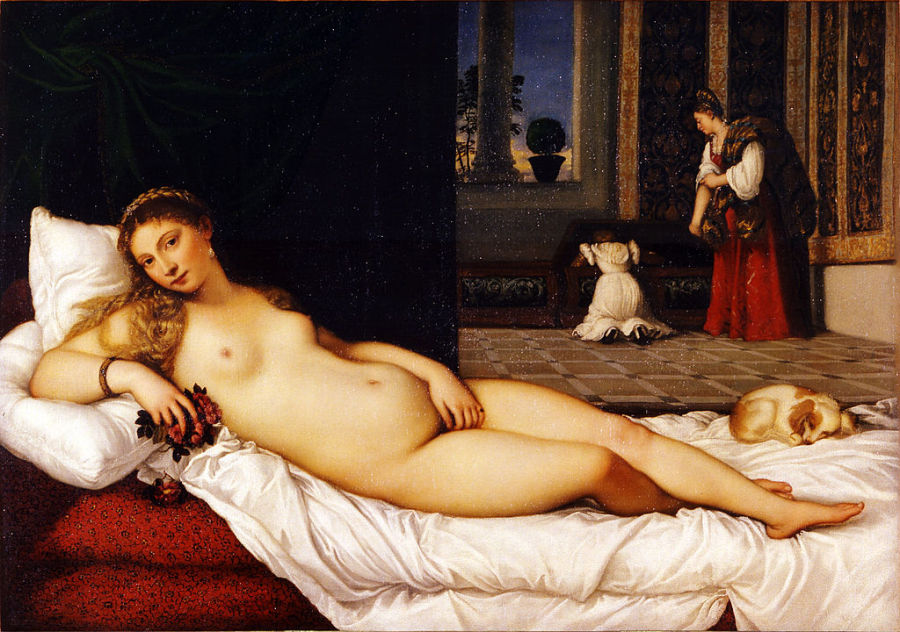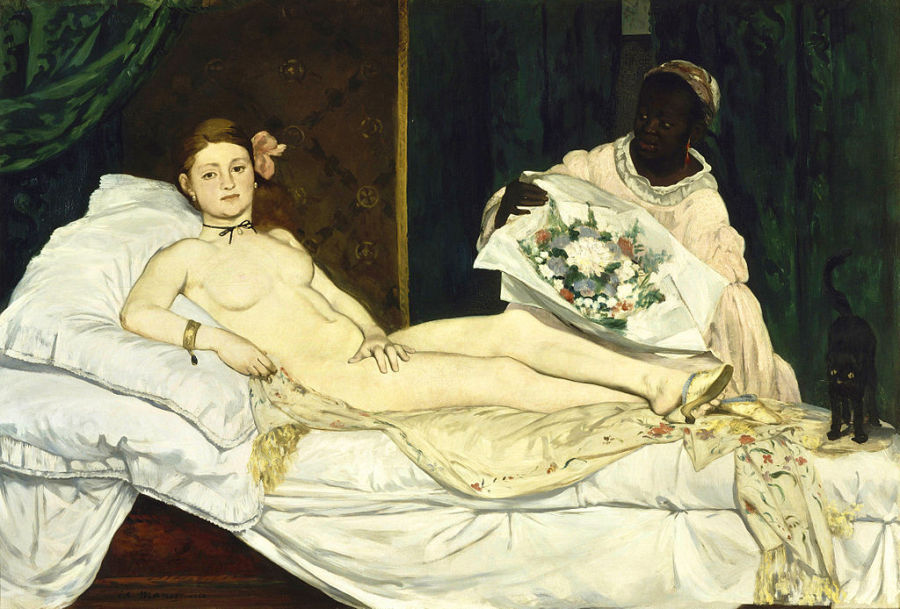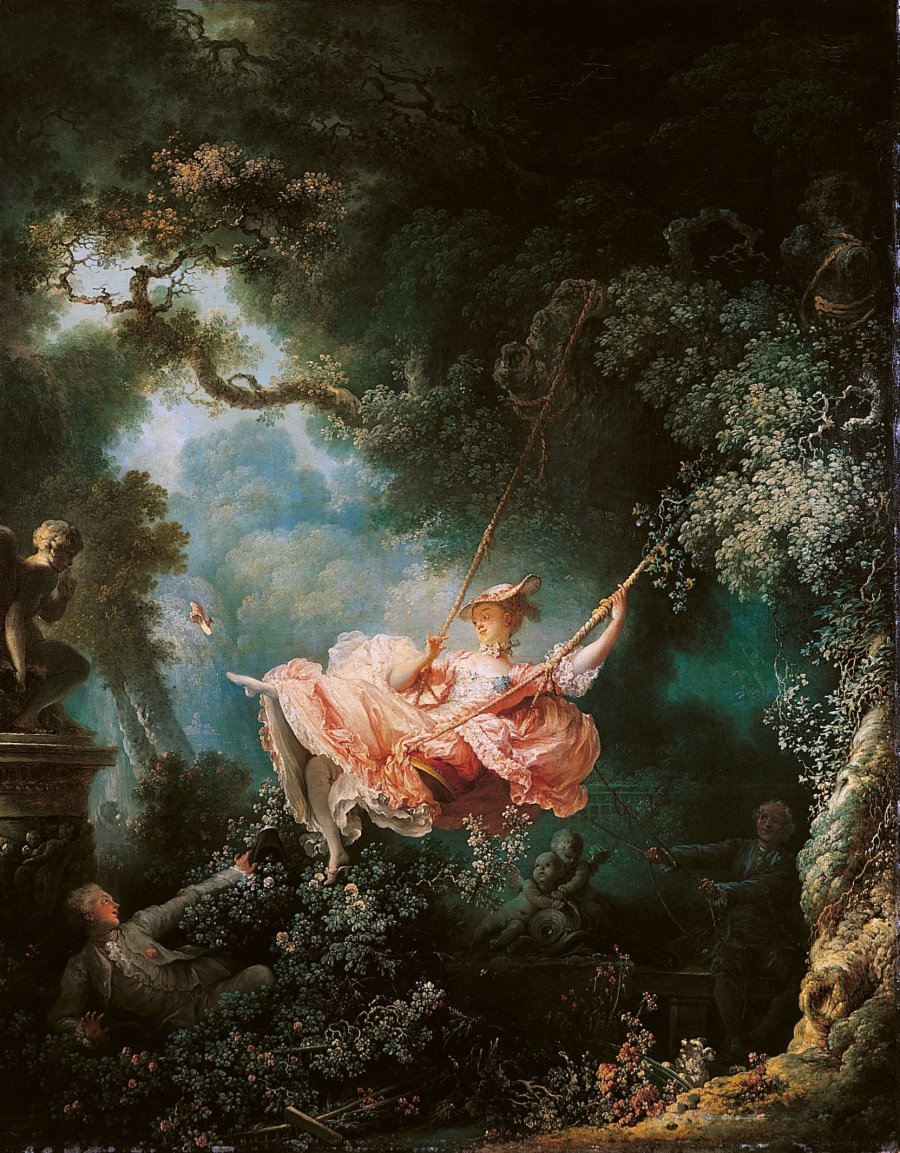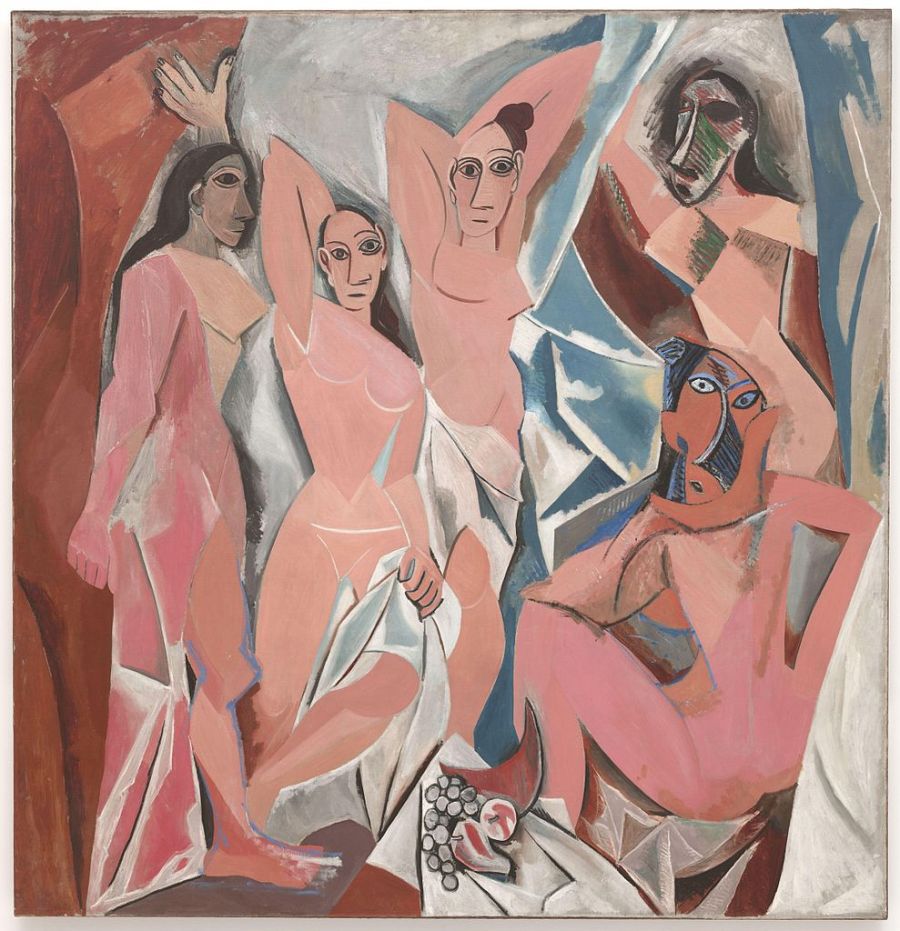 |
Gustave Courbet "L'Origine du monde"
(The Origin of the World) 1866
Need I say more!
|
 |
Jules Joseph Lefebvre "La Cigale" 1872
Despite winning
the Prix de Rome in 1861 and exhibiting 72 portraits in the Paris Salon between
1855 and 1898, Jules Joseph Lefebvre is a second-tier artist. Still, the French
figure painter, theorist, and educator had a proclivity for painting beautiful
naked women. La
Cigale resides in the National Gallery of Victoria in Melbourne,
Australia. While the woman’s smooth, milky white skin and idealized proportions
(as well as her Barbie doll lack of vagina) are in keeping with the classical
figure painting trends of the day, the expression on her face isn’t. Call it a
sexualized pout. Call it the look of the girl-next-door playing shy. Whatever
you want to call it, it’s a coy, contemporary, Lolita-like
expression that not only and heightens the sexual charge of the painting, but
drives men crazy.
|
 |
Paul Cezanne "Seven Bathers"
Cezanne is well known for his various images of nude bathers,
many of whom were women. "Seven bathers," however, portrays the
figures of nude men -- though some are rather androgynously rendered. This
scene of beautifully crafted male bodies is surely not the most erotic of
subject matter, but the ways in which the artist toyed with classical
representations of the body and the relationship between the viewer's gaze and
nakedness makes for a borderline erotic aesthetic. It is assumed that Cezanne,
due to a lack of available models, painted this from memory or imagination.
|
 |
Titian
"Venus of Urbino"
Mark Twain
once called Titian's Venus "the foulest, the vilest, the
obscenest picture the world possesses." With
her unabashed nudity and strong gaze into the viewers' eyes, the nude female in
this 1538 work of art is undeniably erotic.
|
 |
Gustav Klimt "Frau bei der Selbstbefriedigung"
Klimt, the
Austrian symbolist painter with a penchant for gilded canvases, brought you
uber-famous works like "The Kiss" and his portrait of
Adele Bloch-Bauer I. While those images, not to mention the many nude figures
that populate his other paintings, exude sensuality, there's nothing quite as
erotic as "Frau bei der Selbstbefriedigung."
|
 |
Peter Paul Ruben “Copy of Michelangelo's Leda and the Swan"
For early 17th century audiences, it was likely more
acceptable for a woman to be shown engaging in explicit acts with a bird than
with an actual human being. Hence, "Leda and the Swan," based on the
Greek myth in which Zeus takes the form of a swan and "seduces" a
woman named Leda. Artists like Cesare da Sesto and Paul Cezanna also chose the
crude story as inspiration for paintings.
|
 |
Miyagawa Isshō's "Spring Pastimes"
Created in 1750, this shunga scroll depicts a tryst between
two men, one likely a samurai and the other a kabuki actor taking on a sexualized female role.
|
 |
Édouard Manet "Olympia"
Manet's 1863 painting is based roughly on Titian's
"Venus" and Goya's "Nude Maja." According to accounts from
writer Antonin Proust, the painting of a prostitute was so scandalous that
"only the precautions taken by the administration prevented the painting
being punctured and torn" at its debut exhibition.
|
 |
Jean-Honoré Fragonard "The Swing"
This Rococo masterpiece from 1767 is full of
symbolism, all of which centers on a young woman's extramarital affair. See
that man hidden in the bushes on the left side of the canvas? He's not only on
the receiving end of that kicked-off shoe, he's also getting quite a peek up
the woman's dress. Erotic? Maybe. We'd settle for 18th century creepy |
 |
Pablo Picasso "Les Demoiselles d'Avignon" (The Young
Ladies of Avignon)
Picasso's famous Primitivist painting portrays five nude
prostitutes allegedly from a brothel in Barcelona. With their unconventional
female forms and relentless gazes, the image is a proto-Cubist version of
erotica.
|
 |
| Egon Schiele "Friendship" Despite the title, there's a underlying sense of sexuality in Schiele's depiction of two naked individuals, embracing in a twist of line and form reminiscent of the great Austrian painter's intense figurative works. |
 |
| Diego Velázquez "Rokeby Venus" (The Toilet of Venus) Call it "The Toilet of Venus," "Venus at her Mirror," "Venus and Cupid," or "La Venus del Espejo," Velázquez's nude painting shows a woman deriving pleasure from the site of her own naked self. For a painting made between 1647 and 1651 -- a time period marked by the Spanish public's disdain for naked bodies in art -- the work was on the salacious side. |
 |
Titian "Danae" 1544
A woman prepares to make love to a God in this heavenly painting. Jupiter comes to Danae in the form of a shower of gold – a joke with an edge. The model may have been a courtesan and the lover of the cardinal who commissioned this painting, so money was changing hands in their love life. Yet there's something overwhelmingly spiritual about this scene. Titian here raises sex into a religion.
|
 |
Michelangelo “Fig Leaf for David”1857
|
 |
Rembrandt van Rijn "Jupiter
and Antiope" 1659
Luca Giordano "Venus, Mars, and the Forge of Vulcan" circa 1660's
|
 |
| Japanese watercolour "Woman and Man with Oysters" |
 |
| John AS Coutts, aka John Willie "SDM BNDG GAG" 1938 (Sadomasochism Female, Bondage Gagged) |
 |
| "Erotic scene on the rim of an Attic red-figure kylix" circa 510 BC |
 |
| Roman oil lamp depicting coitus more ferarum (doggy style sex) |
 |
| Peter Johann "A Man and Woman engaged in a Doggy style position" |
 |
| Édouard-Henri Avril "Anal Sex Detail" (Two men engaged in a doggy style position) |
 |
| Ancient Roman oil lamp (circa 1st Century AD) depicting a Roman Threesome (woman having sexual intercourse with two men simultaneously) |
 |
| Roman Spintria (Brothel token) |
 |
| "Sunga Love Scene" Shunga Empire sculpture (India), 1st century BC |
 |
| Pederastic Courtship scene on an Athenian black-figure Amphora from the 5 BC |
 |
| The Warren Cup (Julio-Claudian dynasty, Year 10, 1st century AD)One side of the Warren Cup depicts a "bearded man" and a "beardless youth" engaging in anal sex in a reclining position, with the youth lowering himself using a strap or sash to be penetrated. A boy watches from behind a door. The two figures do not appear to be a great difference in age and are of a similar size. The apparent weight of the upper figure, as he lowers himself onto his lover's penis using the support, makes this a non-traditional passive role. |
 |
| The Warren CupThe other side depicts another scene of anal sex, between a "beardless" and clean-shaven "young man" and a smaller figure with long hair indicating he is a "boy" or "adolescent" (now the "eromenos"). The boy's hairstyle is typical of the puer delicatus, a servant-boy or cup or armour bearer. Roman same-sex practice differed from that of the Greeks, among whom pederasty was a socially acknowledged relationship between freeborn males of equal social status. Roman men, however, were free to engage in same-sex relations without a perceived loss of masculinity only as long as they took the penetrative role and their partner was a social inferior such as a slave or male prostitute: the paradigm of "correct" male sexuality was one of conquest and domination. There are significant differences to pederastic scenes found on classical Greek vases. The sex act is presented in graphic detail, and the boy appears to encourage the penetration, grasping his lover's arm. In Roman artwork there is an assumption that the penetrated youth is a slave or prostitute and on the Warren Cup, a mutual tenderness is represented.
Both scenes show draped textiles in the background, as well as a cithara (appearing as an eleven stringed lyre, often symbolic of pleasure and drinking parties) in the former scene and tibiae (reeded pipes) with finger holes being depicted in the latter. These, along with the careful delineation of ages and status and the wreaths worn by the youths, all suggest a cultured, elite, Hellenized setting with music and entertainment.
The active partners in the two sexual depictions are wearing leaf crowns, likely to be symbolically made from myrtle. Myrtle is an evergreen shrub, grown in the Roman period for medical and ritual purposes, such as weddings, and dedicated to Venus, the Roman goddess of sexuality and love. It has a smaller leaf than the more commonly depicted laurel. Myrtle was used to create the corona ovalis, a military crown awarded as an ovation but a far lesser award than the insignis corona triumphalis, one interpretation of the use of myrtle crowns on the Warren Cup, being a visual pun of homosexual penetration as an easy victory.
|
 |
| Hoby Silver Skyphoi (dated to AD 10–20) showing nude male figures in relief |
 |
| Caravaggio "Amor Vincit Omnia" (Love Conquers All)
often interpreted as an
idealized expression of pederastic love
|
 |
| Jupiter abducting Ganymede (1st-century AD Roman statue) |
 |
| An Indian Prince and his attendant (Mughal pederasty painting) |
 |
| Hua Ying Chin Chen The Way of the Academicians (1368–1644) China, Ming Dynasty (Variegated Positions of the Flower Battle) Chinese homoerotic print |
 |
| Henry Scott Tuke "Noonday Heat" (1911) Many of Tuke's most well-known works are nudes of young men and boys |
 |
| Ganymede rolling a hoop and bearing aloft a cockerel – a love gift from Zeus In ancient Greece, a cockerel was a conventional gift from an erastes (adult male) to an eromenos (adolescent boy) in a socially acknowledged erotic relationship |
 |
| Achille Devéria "Libertine" (watercolour) The explicit erotic scene is taking place clandestinely against the background of a 'respectable' party seen at the back |
 |
Erotic Netsuke (miniature
sculptures)
made of mammoth ivory sculptured in Japan |
 |
| "Fellatio" Moche (ancient Peru) ceramic (circa 200AD) |
 |
| Jan Ciągliński "Symbolic Dance" subtle lesbian erotica late 19th-century |
 |
| Oinochoe by the Shuvalov Painter, circa 430-420 BC |
 |
| Peter Fendi "Erotic art" |
 |
| Peter Fendi "Erotic Scene" |
 |
| Katsushika Hokusai "The Adonis Plant" (Fukujusô) 1815 |
 |
| Édouard-Henri Avril |
 |
| Peter Johann Nepomuk Geiger |
 |
| Sheela na Gig |
 |
| Agostino Carracci "Jupiter et Junon" (1557 - 1602) |
 |
| "Khajuraho Temple" Erotic wall sculpture |
 |
| "Tuhfet Ul-Mulk" Turkish Erotic Manuscript |
 |
| "A man enjoying an erotic dalliance with two boys seated" Chinese Erotic Art |
 |
| John Singer Sargent "A Nude Boy on a Beach" (1878) |
 |
| George Wesley Bellows The Barricade (1918) A painting inspired by an incident in August 1914 in which German soldiers used Belgian townspeople as human shields |
 |
| Polykleitos "Doryphoros" |
 |
| Praxiteles "The Marathon Youth" 4th century BC |
 |
| Lysippos "
Hermes"
|
 |
| Praxiteles "Venus Braschi" (Knidian Aphrodite) |
 |
| Sandro Botticelli "The Birth of Venus" |
 |
| Titian "Venus and the Lute Player" |
 |
| Albrecht Dürer "Adam and Eve" 1507 |
 |
| Michelangelo "Creation of Adam" 1512 |
 |
| Lucas Cranach the Elder "Reclining Nymph" |
 |
| Titian "Venus of Urbino" 1538 |
 |
| Hugo van der Goes "The Fall" |
 |
| Peter Paul Rubens "The Three Graces" |
 |
| Rembrandt Harmenszoon van Rijn "Bathsheba at Her Bath" 1654 |
 |
| Francisco Goya "Horrors of War" 1810s (No 37 of 80) |
 |
François Auguste René Rodin "The Age of Bronze" 1877
modeled after a Belgian soldier |
 |
| Pierre-Auguste Renoir "The Large Bathers" 1884-1887 |
 |
| William-Adolphe Bouguereau "The Wave" 1896 |
 |
| Amedeo Modigliani "Nu Couché" (Red Nude) 1917 |
 |
| Gaston Lachaise "Standing Woman" 1932 |
 |
| Lilith Periodo de Isin Larsa y Babilonia (The Burney Relief, Old Babylonia) around 1800 BC |
 |
| Khajuraho Vishvanath Kandariya Mahadev Temple Temple 1050 erotic detail |
 |
| Kitagawa Utamaro "Woman Bathing In Cold Water" circa 1753 |
 |
| "Indian Woman Putting On Her Clothes" 1775 |
 |
| Hashiguchi Goyô "Yuami" Woodcut 1915 |
 |
| Michelangelo "Study of a Kneeling Nude Girl for The Entombment" |














No comments:
Post a Comment